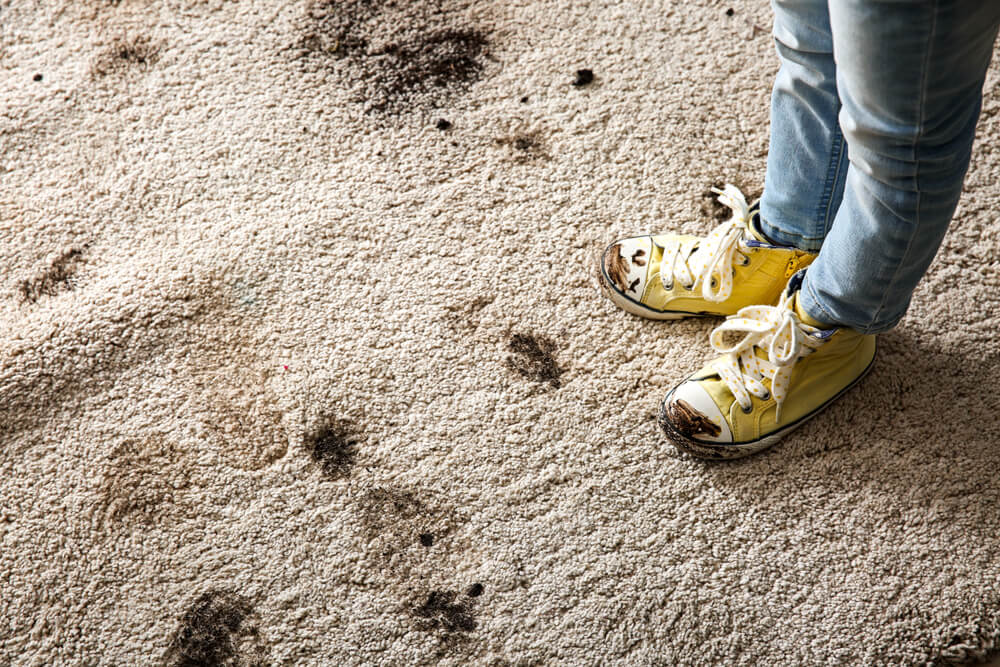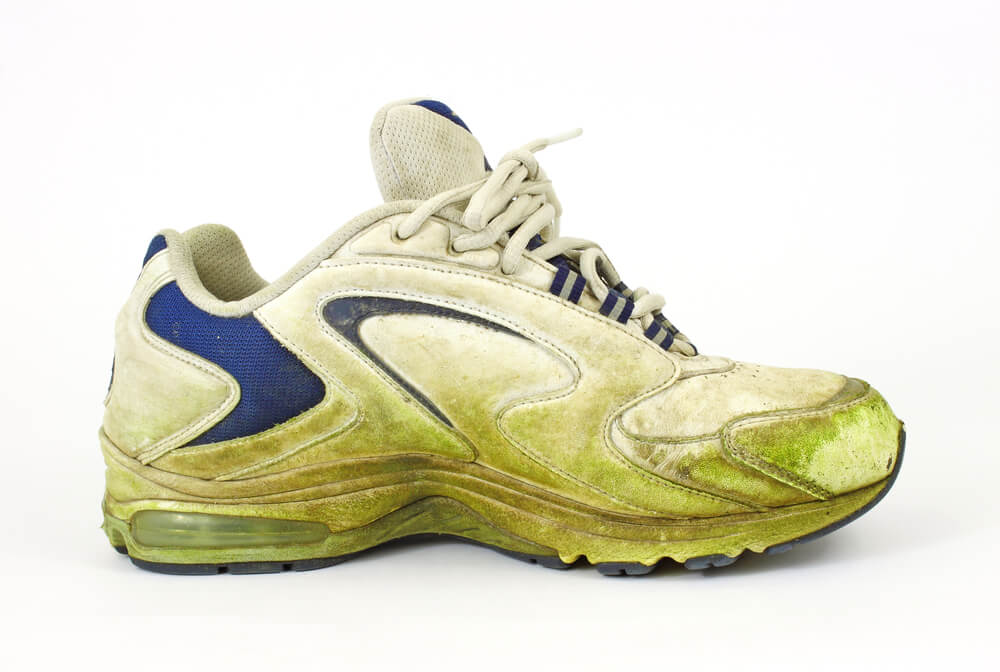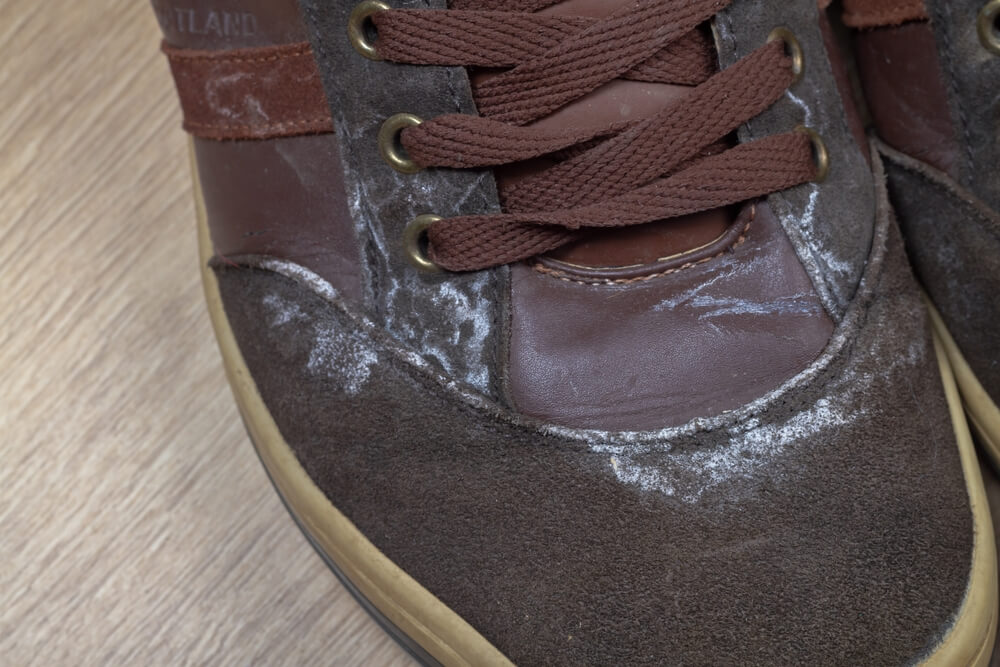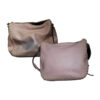Let’s face it, life can get messy – and so can our shoes! We try our best to avoid it but it’s inevitable that our footwear gets dirty from daily use. Whether it’s a stubborn grass stain or coffee stains from your busy rush to work, it’s bound to happen – but what should you when it does happen? In this article, we’ll go over why you should treat stains right away, the different types of stains and how.
Can You Remove Stains From Shoes?
In short, yes! You can remove stains from dirty shoes. There are a number of stain removal methods which you can utilize. Which one you choose will depend on how dirty the shoe is as well as the type of material and stain. Depending on these factors, the steps involved will vary.
Yellowing soles on white sneakers is commonly mistaken for a traditional stain. Unfortunately, this process is due to oxidation and almost impossible to avoid. To learn more, read our guide on oxidation.
Are All Stains Treated the Same?

Though most stains will come out with dish soap and a little bit of elbow grease, different stains may require different treatment. For example, steps involved to remove blood stains will differ from mud and dirt.
Additionally, removing stains from more delicate materials such as suede shoes or speciality leather shoes will require a gentler approach – taking up more time and patience. For times when you need expert help, consider opting for a shoe spa treatment from a professional such as Shoewash Supreme.
The Importance of Treating Stains Right Away
There are a number of reasons why you should keep your shoes clean. However, there is one main reason why you should treat stains as soon as possible. The longer a stain remains, the more difficult it is to remove. This applies to all apparel and accessories including clothing, shoes and handbags.
Over time, tougher stains like red wine or ink stains will seep deeper into the material of your shoe or purse – requiring a more intensive cleaning method. When left untreated, they can even stain permanently and become impossible to remove.
Layers of Stains
As previously mentioned, not all stains are the same. This is because different foods and fluids penetrate particular materials differently. When it comes to stains, there are typically three layers:
Surface Stains
Surface stains are the easiest to remove because they sit on top of your shoe or handbag’s finisher. They are caused by things like dirt, dust, and food, and can usually be removed with a simple wipe or cleaning.
Penetrated
Once the stain has penetrated through to the shoes finisher, it becomes more tricky to remove. You will require some heavy duty laundry detergent, a deep scrub and some ample soaking time.
Damaged
The most damaging stains are those that have seeped in deep enough to reach the paint layer of your shoes or handbags. They are often impossible to remove with any amount of cleaning and can require a new layer of paint to cover.
Different Types of Stains

It’s no surprise that some stains are more difficult to remove than others. In this section, we’ll go over the most common types of stains and how you can treat them. Want to save your precious time instead? Consider looking into professional cleaning services.
Mud and Dirt
Not only are mud and dirt stains almost impossible to avoid, they can take a lot of scrubbing to remove. It’s important to clean them sooner than later as it can dry and deteriorate your shoes material. Plus, depending on what that material is, you might not always be able to just throw them into a washing machine.
To clean, let the mud dry and use a soft bristled brush to scrub the shoes down. When dry, the mud will crumble off – making the process a breeze. Be sure to do it outside or over a covered area as the mud and excess dirt will fall and leave a mess behind.
Once your shoe is clean of any major clumps of mud, you can wipe it down using a damp cloth and cleaning solution. Note: If you are cleaning suede or nubuck leather, please skip this step as it can cause marks.
Oil
Oil stains require fast treatment as they tend to set quickly. If it happens, you can try and soak it up with talcum powder or salt.
- Pour talcum powder or salt on the oil stain.
- Using a soft bristled brush, gently brush and remove the powder.
- Repeat the process until the stain starts to lift. Be patient!
Grass

Grass stains are some of the toughest stains to remove – especially from white shoes or canvas shoes. Depending on your shoes material, you can treat with the following household items:
Baking Soda
We’ve previously mentioned this tip in our guide for how to clean shoelaces. Not only is it something that most people will have around the house, it can be an extremely effective stain remover – especially on canvas shoes. Plus, it provides a solution to remove grass stains without the use of chlorine bleach. Follow the steps below:
- Mix 4 oz of warm water and lemon with 4 tablespoons of baking soda to create a paste.
- Cover the stained fabric with the paste and let soak for at least 15 minutes.
- Using an old toothbrush and water, scrub the area until the stain lifts. Deeper stains may require a little extra effort to remove.
Distilled White Vinegar
This cleaning method is inexpensive and known as a highly effective stain removal method.
- Mix 1 part distilled white vinegar with 1 part water.
- Coat the stained area and let sit for up to 30 minutes.
- Scrub the stain with a soft brush until it lifts, then rinse with cold water.
- Follow up with a bit of dish soap and wash as usual: Soak, scrub and rinse.
Plain White Toothpaste
Grass stains can also be removed using regular toothpaste for times when you’re in need of fast treatment. Be sure to use only the paste variety and not gel.
- Use a small amount of toothpaste and cover the stain.
- Dip a toothbrush into warm water and scrub the area gently.
- Rinse and repeat as needed until the stain lifts.
Water
If you have owned suede or leather shoes, you probably have seen the lasting damage that comes from water marks – especially if you live in Vancouver, B.C! The ironic thing is that you can also use water to remove the water stains.
- Stuff the shoes with newspaper or dry paper towel to help retain their shape during the cleaning process.
- Using a brush, apply a light coat of water to the whole shoe.
- Let the shoes air dry for a few hours or overnight in a well-ventilated area.
- Once completely dry, use a suede brush and rub the shoes down.
For a more tips and tricks, read our guide on treating wet suede.
Salt, Snow and Slush

Winters in Canada can be tough. When you’re walking around in snow and slush all day, it’s practically impossible to avoid salt stains on your shoes.
Salt stains are detrimental – especially on leather and vinyl. When left untreated, they eat through the shoes surface, leaving irreparable damage. To learn more, check out our guide on how to survive salt stains this winter.
You can treat salt stains at home using white vinegar. Simply follow these steps:
- Stuff your shoes with white paper towels to help them keep their shape.
- Mix a cleaning solution made of one part white vinegar and two parts water.
- Using a clean cloth, dab the solution onto the salt stain.
- Follow up with a clean damp cloth to remove any excess vinegar.
- To finish, dab the stain using a dry cloth.
Coffee
It can be a huge pain to get coffee stains out of suede shoes. Luckily, you can treat them with the same white vinegar solution mentioned above!
- Stuff the shoes with paper towels to help them retain their shape.
- Using a clean cloth, warm water, and a bit of dish soap, blot the coffee stain gently to remove any excess coffee.
- Mix one part white vinegar and one part water.
- Blot the solution onto the stain, rubbing gently until it lifts.
- Once the stain has been removed, leave your shoes to air dry in a well-ventilated area.
- After they dry completely, use a suede brush and re-fluff your shoe.
Red Wine

Tough stains like red wine can seem like they are almost impossible to remove. Plus, when you scrub them, they typically spread and seep deeper – getting worse and worse.
Treat wine stains as soon as possible for the greatest chance of removal. For times when you’re in a pinch, a little bit of liquid detergent and hydrogen peroxide can be an effective stain remover! Just follow the steps outlined below:
- Mix 3 parts of hydrogen peroxide with 1 part of liquid dish detergent.
- Use a dry cloth and apply the cleaning solution to the red wine stain.
- Let soak for 30 minutes to 1 hour.
- Gently blot the stain until it lifts.
- To finish, wash as usual using soap and hot water.
Different Types of Material
Just like how all stains are not treated the same, different types of material also require different methods of cleaning. You don’t clean white canvas shoes the same way that you would clean suede such as Uggs.
Always ensure that you do some research before attempting to clean your shoes at home. Especially if they are made of delicate or specialty materials. To learn more techniques, read our guide on rubber boot cleaning. Additionally, test your cleaning solution on a small area before treating your whole shoe.
Tips for Treating Tough Stains

There’s nothing worse than looking down at your shoes and seeing a stain. Whether it’s from rain, mud, or spilled food, stains can ruin the look of even the nicest pair of shoes. Here’s some extra tips for treating tough stains on your shoes.
First, try using an enzyme-based stain remover specifically designed for your shoes material. These products can be found at most shoe stores or online. Once you’ve applied the stain remover, let it sit for a few minutes before wiping it away with a clean cloth – especially when dealing with dried stains.
Giving the solution time to soak will enhance its effectiveness and increase the chances of getting it out. If the stain is still visible, you can try using a toothbrush to scrub it gently.
Another option is to take your shoes to a professional shoe cleaner. They will have the equipment and expertise to remove even the most stubborn stains.
Finally, remember that prevention is always better than cure. You can reduce the risk of stains by regularly cleaning and polishing your shoes. This will create a barrier against dirt and water, making it easier to wipe away any spills before they have a chance to stain.
Now that you know why it’s important to treat stains right away and how to treat them, you can keep your shoes looking new for longer. For more shoe care guides, read our 10 shoe cleaning tips.
Tags: shoe cleaning





